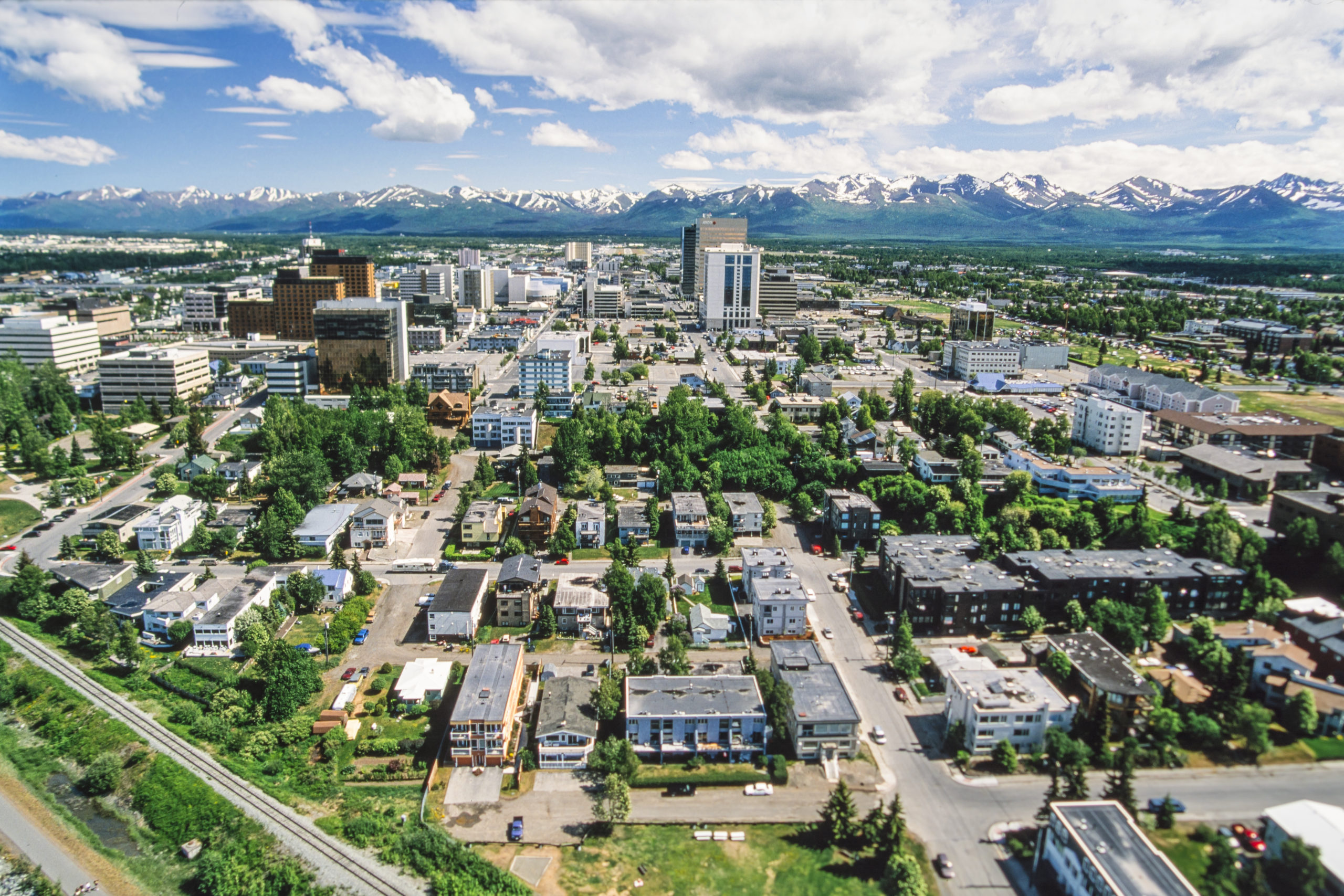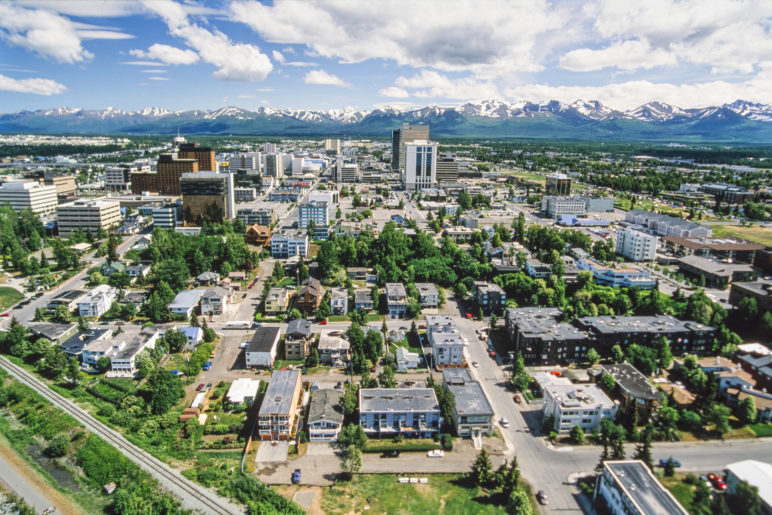In-law apartments, backyard cottages, and other types of “bonus housing” known as accessory dwelling units (ADUs) just became easier to build in Anchorage, with a remarkable package of zoning code reforms that took effect last month. The reforms signal a new willingness by elected officials here to reverse housing-unfriendly land use rules that have led to a shortage of attainably priced homes, record-high prices, and a one-style-must-fit-all housing market. They also better serve the needs of the city’s changing population, where in the last 20 years the market share of small households (one- and two-person) has grown, and larger ones (three-person or more) has shrunk.
ADUs, or “bonus homes,” are relatively modest but complete living spaces paired with at least one main unit on the same lot. Anchorage’s amended ADU codes aren’t just significant locally. In aggregate, they put Alaska’s largest city out front nationwide in making it easier to add a home to properties where at least one home already exists. The Anchorage Assembly approved the changes 9–1 in January, with votes on the nominally nonpartisan body coming from both right- and left-leaning members. The mayor’s office also cheered on the removal of regulatory barriers.
Bonus homes are a throwback to a time when America’s housing market was less burdened by regulation and therefore more affordable. They allow multiple generations of a family to live together, increase property values and income for owners, and give renters more options in desirable neighborhoods near trails, schools, restaurants, and other community anchors. They can help retired and working-age people stay in Anchorage rather than leave for cities where their housing dollars go further. In neighborhoods that want more walkability, ADUs complement reforms that encourage upzoning, allow homes and businesses to coexist, and turn walking, biking, and public transit into desirable options.
Bonus homes were trending even before the COVID-19 pandemic drove up demand for more space at home. First-time listings of ADUs across the United States increased an average of 8.6 percent between 2009 and 2019, according to a report from nationwide mortgage finance company Freddie Mac. Dallas, Seattle, and Miami were among the fastest-growing markets. In 2019, Freddie Mac counted 1.4 million single houses in America with permitted ADUs.
Anchorage’s ADU reforms allow a bonus home in all commercial and residential zones and on all kinds of housing, including large, multifamily buildings. Owners can build a bonus home, or buy a home that comes with one, but no longer have to live on the property. Design-based barriers, including square footage, height, and architectural requirements, were eased or eliminated. The ordinance requires the city planning department to help people navigate the permitting process and start tracking the number of ADUs. Anchorage already did away with parking mandates, another design-related impediment to ADUs, in a separate ordinance last year.
“Bonus homes” on all kinds of housing
Most cities limit ADUs to lots with single houses in residential zones. But Anchorage now allows them with multifamily homes, too. The reforms give property owners the option to, say, add a basement apartment to a duplex or a bonus unit in an apartment complex, provided the project meets other zoning requirements. They’re also now allowed on residential property in commercial zones, like parts of downtown and the Fairview neighborhood.
The original draft ordinance called for allowing ADUs on properties with duplexes, not just single houses. But progressive-leaning Assembly Member Meg Zaletel, who represents Anchorage’s Midtown district, proposed allowing them on all housing types in all residential and commercial zones.
Zaletel’s amendment effectively makes at least 8,000 properties, from duplexes to triplexes to garden apartments, newly eligible for ADUs, as long as the project meets other zoning requirements. (This very rough and conservative estimate is based on municipal building type data from 2021 provided by Cook Inlet Housing Authority.)
“This allows an accessory dwelling unit to be created anywhere there is already a dwelling unit on a parcel,” said Zaletel, who is also executive director of the Anchorage Coalition to End Homelessness. “It can include triplexes, fourplexes, sixplexes on up.”
“There are actually a lot of multifamily buildings out there that have areas for an additional unit. I wish I’d thought of this. I love it.”
–Anchorage Assembly member Kevin Cross

Anchorage isn’t the first jurisdiction to allow the pairing of ADUs with multifamily homes. California also allows ADUs (sometimes more than one) on multifamily properties. The mortgage industry is taking notice. Previously, Freddie Mac would only buy mortgages on properties with ADUs if the main dwelling was a single house. In June 2022, the lender revised its policies to buy mortgages to properties with either a duplex or triplex and one ADU (but no more).
Assembly member Kevin Cross called Zaletel’s amendment an “excellent idea.” A commercial real estate and loan broker representing conservative-leaning Eagle River, Cross has seen potential bonus home conversions, from old garages to storage areas, go unbuilt because of zoning restrictions.
“There are actually a lot of multifamily buildings out there that have areas for an additional unit,” Cross said. “I wish I’d thought of this. I love it.”
The Assembly passed the amendment 10–0. Whether growth actually occurs on these newly eligible properties will depend on the effects of other zoning restrictions, market demand, architectural limitations, and the ability of prospective builders to obtain financing.
Owners don’t have to live on the same property as their aDUs
Before the reforms, owners planning to build a bonus home or buy property with an ADU had to sign a sworn statement promising to live on the land for more than six months of each year. No other housing type in Anchorage, aside from rooming houses, had an owner occupancy requirement. Owners of single houses, duplexes, and triplexes on up could already rent out units on their property without having to live there.
The Assembly took the logical step of voting to eliminate owner occupancy requirements for properties with ADUs, opening up to 10,500 single-family rental homes in Anchorage to bonus home development. (Other rules in the zoning code may make some percentage of these lots ineligible.) Based on similar policy changes in other cities, a small fraction of the owners of these properties will actually add a bonus home. Some of the new units will become short-term rentals. Some will never go on the rental market. And some will add to the housing stock as long-term rentals.
Owner occupancy requirements assume that renters, specifically those living in an ADU, need special oversight and that the owners are uniquely qualified to provide it. But as appellate judges in a 2019 New Jersey owner occupancy dispute pointed out, “the status of a house’s occupant as a property owner rather than as a tenant is no guarantee that he or she will be a law-abiding and considerate neighbor.” The judges also noted that deed restrictions, such as owner occupancy laws, “cannot functionally delegate to a private landlord a portion of the municipality’s police powers.” On those and other grounds, courts in New Jersey, North Carolina, and other states have struck down owner occupancy requirements. Eradicating the owner occupancy requirement eliminates the risk of such litigation for Anchorage.
Like Anchorage, other cities have repealed owner occupancy requirements as part of a package of ADU reforms. So, it’s hard to know exactly how many ADUs will be built as a direct result of this particular policy change. Seattle, which also did away with owner occupancy requirements in 2019, among other reforms, issued permits for a record 513 bonus homes in 2020. The number continued to rise, according to the city’s 2021 ADU annual report. And in 2022, Seattle built more ADUs than single houses for the first time. Anchorage, with less than half the population of Seattle and much higher building costs, will likely see a smaller number of ADUs built.
The elimination of owner occupancy requirements will also help the city keep a more accurate count of ADUs. The city had been tallying them using signed owner occupancy affidavits and assessor data. It was an imperfect system; anyone who intended to build an ADU had to sign an affidavit well before the project was complete. Following the reforms, the Planning and Private Development departments added a new ADU checkbox on incoming building permits. Allowing permit applicants to flag projects that include bonus homes should vastly improve the quality of municipal ADU data.
Builders have more design flexibility
Pre-reform, the city already allowed ADUs on 69,000 single homes in Anchorage occupied by the owner. But by the city’s best estimates, only 1.4 percent of those properties, or about 1,000 in all, have bonus homes. (This statistic includes the city’s estimate of unregistered ADUs.) Moving to less prescriptive design standards, like lifting a prohibition on ADU entry doors facing the street, could allow ADUs on more lots.
An ADU could begin its life as a short-term rental, morph into an office, and transform into long-term housing for elderly relatives, adult children, or renters.

Greater design flexibility makes bonus homes less complicated to build and gives owners more options to change uses over time. An ADU could begin its life as a short-term rental, morph into an office, and transform into long-term housing for elderly relatives, adult children, or renters. Anchorage’s reforms also may make possible bonus home projects that would have been architecturally unfeasible under the old code.
Realizing that homeowners who aren’t professional builders may want to take on an ADU project, the ordinance requires city planners to help people understand the permitting application and review process. So far, the Planning Department has produced an overview sheet highlighting changes to the code and may update it based on questions from the public. The rules occasionally differ for attached ADUs (AADUs), those units that are part of the main dwelling, and detached ADUs, like backyard cabins and above-garage apartments. And there may be some differences between ADU zoning code in Eagle River, the Anchorage Bowl, and Girdwood. The table below focuses on old and current ADU code in the Anchorage Bowl, where most residents live.
ADU Regulatory Changes for the Anchorage Bowl
| Old Code (pre-January 2023) | Current Code (2023) | |
|---|---|---|
| Entry Location | For attached ADUs, the entry door cannot be on the same side as the primary dwelling but may be located on non-street-facing sides. Detached ADUs are exempt. | Bonus home doors may face the street. |
| Number of Bedrooms | Maximum of two bedrooms. | No limit on the number of bedrooms. |
| Maximum Height | Max height is 25 feet for a detached ADU. | ADUs above detached garages can now be up to 30 feet in height, while other freestanding bonus homes and those attached to the main house remain limited to 25 feet. |
| Maximum Gross Floor Area | Class A districts (urban): size may not exceed 900 sq. ft. or 75 percent of the total area of the primary home. Class B districts (rural): size may not exceed 900 sq. ft. or 35 percent of the total area of the primary home | In all districts in the Anchorage bowl, the gross floor area of the ADU, not including any related garage, shall be up to 900 square feet or 40 percent of the total gross floor area of the principal dwelling unit, whichever is greater. An ADU shall not exceed 1,200 square feet. |
| Setbacks | For detached: The ADU shall, on all street frontages, either have a front setback of at least 40 feet, or be at least 10 feet behind the street-facing façade of the principal dwelling unit. An ADU shall not encroach into any required setback, except that an ADU may encroach into the side or rear setback abutting an alley. Detached ADUs taller than 15 feet shall adhere to a 10-foot side setback abutting a neighboring R-1 or R-1A lot. | All ADUs now have the same setback rules as the principal dwelling and may encroach into the side or rear setback abutting an alley. But there is an exception: Detached ADUs taller than 15 feet must adhere to a 10-foot side setback abutting any neighboring lot in single-house residential districts (R-1 and R-1A). |
| Architectural Standards | Included the following purpose statement: “Ensure that ADUs maintain and are compatible with the appearance and character of the principal residence, lot, and neighborhood.” | Removed the purpose statement on appearance and character. |
Separately, the removal last year of parking mandates citywide means developers and homeowners, not the city, make the call on whether paving a spot for parking is necessary. Previously, the city required one parking space per ADU, with on-street parking qualifying if the traffic engineer approved. Owners could also have the parking requirement waived by signing a no-car covenant.
Time to match Anchorage’s housing options to its residents’ needs
A significant number of people in Anchorage are living in and paying for square footage that exceeds their actual needs. It’s like being forced to buy a triple-decker burger when all you really want is a side of fries.

With Anchorage’s population shrinking, it’s natural to ask why the city should change its land use codes to add more infill housing, like ADUs and multi-unit homes. The short answer: Anchorage households have gotten smaller, while its homes have gotten larger, according to data from the US Census. That means a significant number of people in Anchorage are living in and paying for square footage that exceeds their actual needs. It’s like being forced to buy a triple-decker burger when all you really want is a side of fries.
Consider this: Between 2000 and 2020, the share of one- and two-person households in Anchorage grew. At the same time, the share of households with three or more people shrank. And yet, Anchorage’s housing market continued to focus on the one-unit-per-lot model—the largest, most expensive housing type. In 2000, 46 percent of occupied homes were single detached houses. Twenty years later, the market share of these houses had swelled to 58 percent.
This is a problem because millions of people in different life stages across four generations are competing for smaller homes on smaller lots. Arthur C. Nelson, who holds urban planning professorships at both the University of Arizona and University of Utah, notes that Boomers and Gen-Xers are downsizing as they age, but Millennials and Gen Z don’t want large homes on large lots. They want to own or rent the same smaller homes on smaller lots or attached homes, especially those in walkable communities, Nelson said.
“The changing demands for the types and location of homes of four generations are going to overwhelm the current and projected supply of homes in those categories unless we change the ways we’re planning and building for that future,” Nelson said
Allowing more bonus homes is a small step toward right-sizing the square footage and the price of housing in Anchorage. So was getting rid of parking mandates. Let’s hope the Assembly and the mayor keep the momentum going and enable homebuilders to give more Anchorage residents the housing they actually want.











Kim M Dobson
This is the Same Missing Middle clone legislation that favors market rate speculator and private equity real estate investors like Black Rock that now have purchased more than A 1/3 of US houseing real estate .They have raised rents to market rate and own many ADU conversions for short term rentals .This Missing Middle clone zoning has been rolled out nationwide and introduced in the Wa legislature with HB 1110 .This legislation was hatched by conservative American Enterprise Institute with backing from the Master Builders and Chamber of Commerce .{ Your editors are very interested in removing any comments that run counter to your one sided developer friendly narratives.)